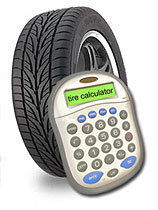Tire Size Calculator
A tire size calculator will remove a lot of the complexity that comes when computing the figures manually.  These calculators are available on the Web for free. If you use a search engine you will see several come up.
These calculators are available on the Web for free. If you use a search engine you will see several come up.
How to Use the Calculator
These calculators will vary in their features, but most will have the following (or at least variants of it). There will be a drop down list where you can choose the car (BMW, Chrysler, etc.) and the year.
For comparing the tire dimensions, you have to choose the thread width, profile and diameter. The number of tires you can compare will vary per calculator.
To compare, select your vehicle stock tire. Choose the one you want to compare it with. Click “compare size” or something similar. These tire size calculators will display the results in inches, millimeters or both.
Note: the diameter will vary for every car model. If you are going to change the tire dimensions, it is best if you stay within 3% of the current diameter and width. If you go beyond that, you risk a brake failure.
Info about the Letters on Tires
Tire specs typically start with letters. These specify what kind of vehicle the tire is made for. The letter P means P-metric. These are for passenger vehicles like cars, light duty pickup trucks and SUVs. If there is no letter before the numeric part, it is a metric size. Metric size is usually for European cars.
If the letter is a T, it is a mini spare or space saver. These tires are to be used until the tire is repaired or replaced. An LT size means the tire is light truck metric. These tires can support heavy cargo trucks and towing.
These include pickup trucks with 1 ton load capacity and full size vans. These have been designed to deal with the stress of lifting cargo. Note: this info is present in some tire size calculators too.
Section Width and Other Info
After the lettering comes the three digit numeric part. This is the section width stated in millimeters. A P225/50R16 91S tire means the tire is 225 mm from the outer sidewall to the inner sidewall.
These measurements are at the widest points of both sidewalls. To get the measurements in inches, remember that 1 inch is equal to 25.4 mm. Example: 225 mm / 25.4 = 8.86".
This figure is followed by the sidewall aspect ratio. This is expressed in two digit numbers. If the tire reads P225/50R16 91S, it means the sidewall height is 50% of the width. This is also known as the tire profile.
These numbers are followed by the letter. This is used to identify the internal construction. A letter R means it is radial construction. Radial tires are the most widely used, with over 97% of sold tires using them. D means it is meant for light trucks.
Keep in mind that tire size calculators are to be used as an information guide only. You should have the vehicle examined by a mechanic if you want to use a different size.





